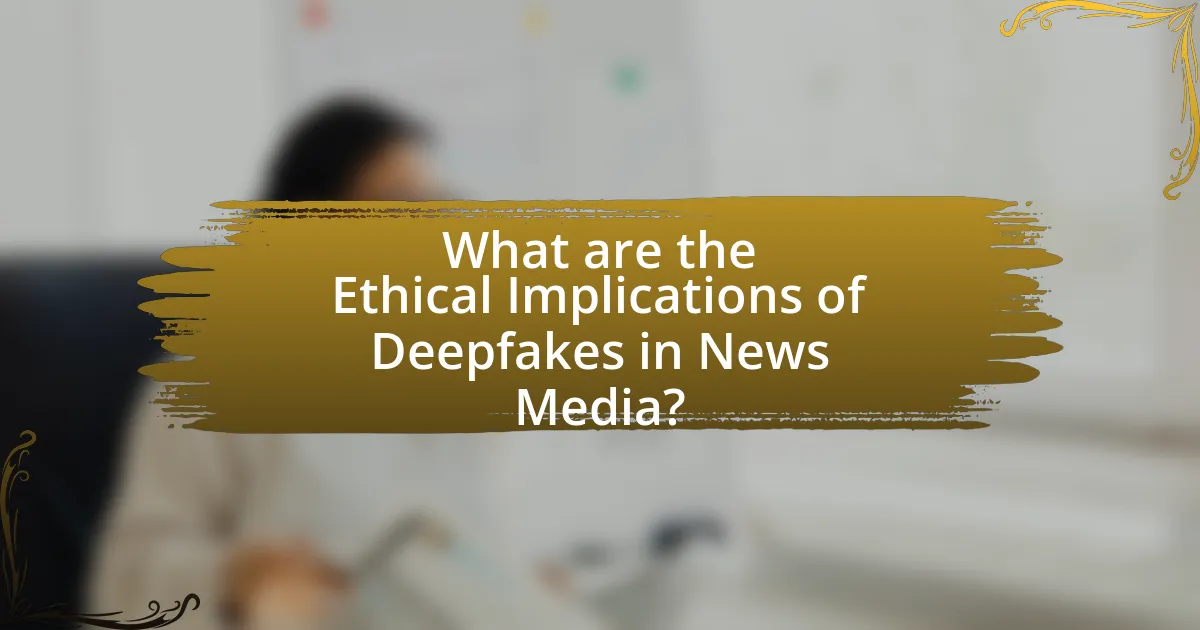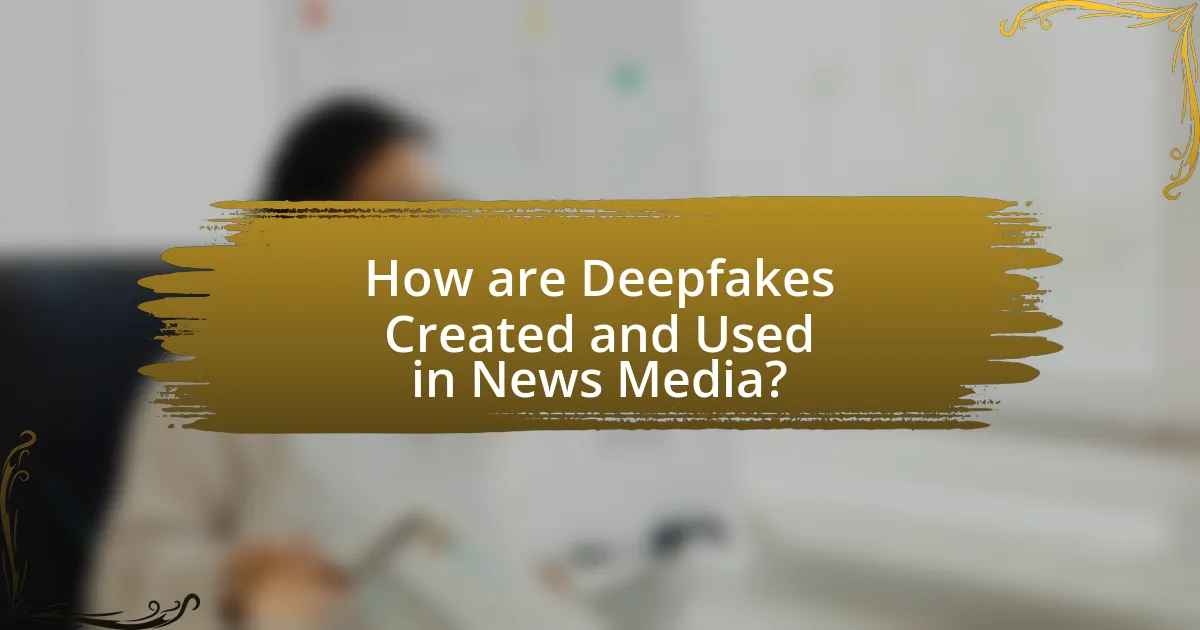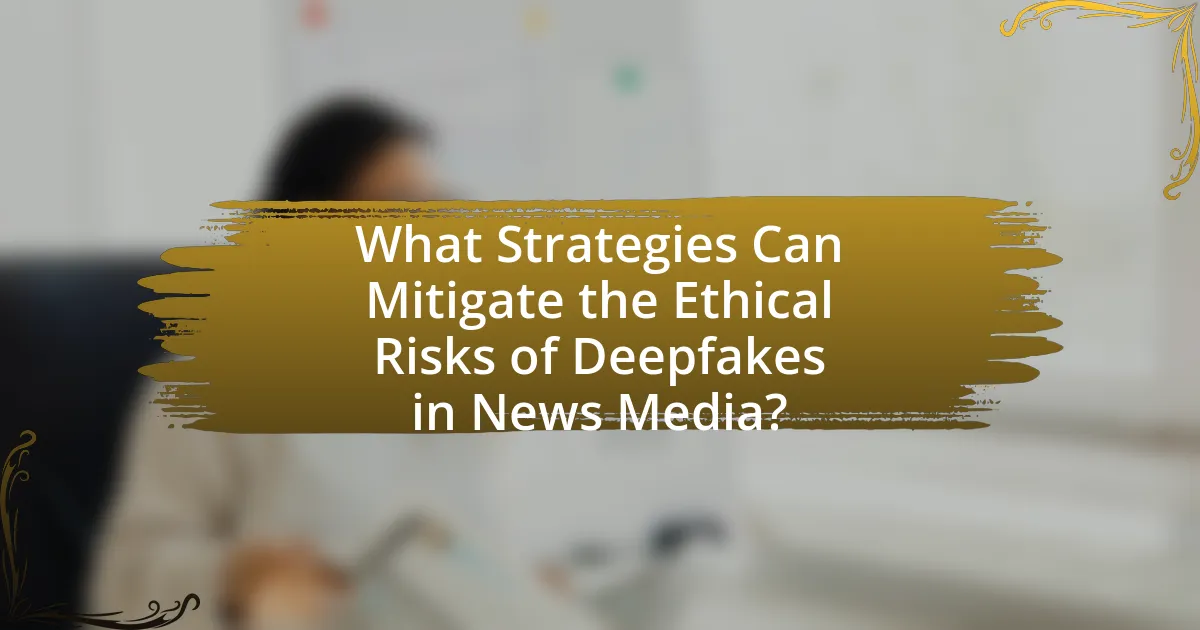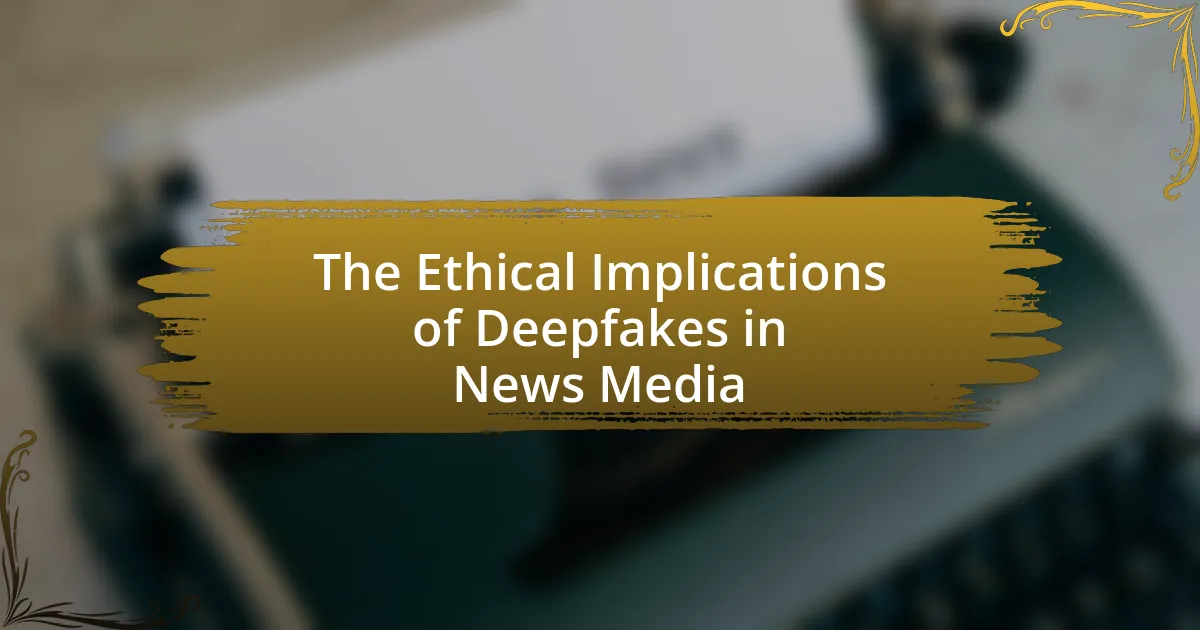The article examines the ethical implications of deepfakes in news media, highlighting their potential to spread misinformation, erode trust, and manipulate public opinion. It discusses how deepfakes undermine the credibility of news sources, challenge the principles of truth and accuracy, and raise significant ethical dilemmas regarding misinformation and reputational harm. The article also explores the responsibilities of journalists in verifying deepfake content, the legal challenges faced by news organizations, and strategies to mitigate the ethical risks associated with deepfakes, including the importance of media literacy and collaboration with technology companies.

What are the Ethical Implications of Deepfakes in News Media?
The ethical implications of deepfakes in news media include the potential for misinformation, erosion of trust, and manipulation of public opinion. Deepfakes can create realistic but false representations of individuals, leading to the spread of false narratives that can mislead audiences. A study by the Massachusetts Institute of Technology found that false news spreads six times faster than true news on social media, highlighting the risk of deepfakes exacerbating this issue. Furthermore, the use of deepfakes can undermine the credibility of legitimate news sources, as audiences may become skeptical of authentic content due to the prevalence of manipulated media. This erosion of trust can have significant consequences for democratic processes and informed public discourse.
How do deepfakes impact the credibility of news sources?
Deepfakes significantly undermine the credibility of news sources by creating realistic but fabricated audio and video content that can mislead audiences. This technology enables the manipulation of information, making it difficult for viewers to discern truth from deception, which erodes trust in legitimate journalism. A study by the Pew Research Center found that 86% of Americans believe misinformation is a major problem, highlighting the widespread concern over the impact of deepfakes on public perception. As deepfakes become more sophisticated, news organizations face increasing challenges in verifying content, further complicating their role as reliable information providers.
What role does trust play in the consumption of news media?
Trust is fundamental in the consumption of news media, as it directly influences audience engagement and perception of credibility. When consumers trust a news source, they are more likely to accept the information presented as accurate and reliable. Research indicates that 62% of Americans believe that news organizations intentionally mislead the public, highlighting a significant trust deficit that affects how news is consumed. This skepticism can lead to selective exposure, where individuals gravitate towards sources that align with their beliefs, further polarizing public opinion. In the context of deepfakes, the erosion of trust becomes even more critical, as manipulated content can exploit existing doubts, making it essential for news organizations to prioritize transparency and fact-checking to rebuild credibility.
How can deepfakes undermine public confidence in journalism?
Deepfakes can undermine public confidence in journalism by creating realistic but false representations of events or statements attributed to public figures. This technology enables the manipulation of video and audio content, making it difficult for audiences to discern truth from fabrication. A study by the Massachusetts Institute of Technology found that 85% of participants could not accurately identify deepfake videos, highlighting the potential for misinformation to spread rapidly. As trust in media relies on the authenticity of reported information, the prevalence of deepfakes can lead to skepticism about legitimate news sources, ultimately eroding the public’s faith in journalism as a reliable information medium.
What ethical dilemmas arise from the use of deepfakes in news reporting?
The use of deepfakes in news reporting raises significant ethical dilemmas, primarily concerning misinformation, trust erosion, and potential harm to individuals. Misinformation arises when deepfakes are used to create false narratives, misleading audiences and distorting public perception. Trust erosion occurs as audiences become skeptical of authentic news sources, questioning the veracity of all media content due to the prevalence of manipulated videos. Additionally, deepfakes can cause harm to individuals by misrepresenting their actions or statements, leading to reputational damage or emotional distress. These dilemmas highlight the urgent need for ethical guidelines and regulatory measures in the use of deepfake technology in journalism.
How do deepfakes challenge the principles of truth and accuracy?
Deepfakes challenge the principles of truth and accuracy by creating hyper-realistic but fabricated audio and visual content that can mislead audiences. This manipulation of media undermines trust in legitimate news sources, as individuals may struggle to discern between authentic and altered content. Research from the Massachusetts Institute of Technology highlights that deepfakes can significantly decrease the perceived credibility of video evidence, as viewers may question the authenticity of all video material, regardless of its source. Consequently, the prevalence of deepfakes contributes to a broader erosion of trust in media, complicating the public’s ability to access accurate information.
What responsibilities do journalists have regarding deepfake content?
Journalists have the responsibility to verify the authenticity of deepfake content before dissemination. This includes conducting thorough fact-checking and utilizing technology to detect manipulated media, as deepfakes can mislead audiences and distort public perception. According to a 2020 report by the Brookings Institution, the rise of deepfake technology poses significant risks to information integrity, emphasizing the need for journalists to uphold ethical standards in their reporting. By ensuring accuracy and transparency, journalists can mitigate the potential harm caused by deepfake misinformation.
Why is it important to address the ethical implications of deepfakes?
Addressing the ethical implications of deepfakes is crucial because they can significantly undermine trust in media and public figures. Deepfakes can be used to create misleading or harmful content that misrepresents individuals, leading to misinformation and potential reputational damage. For instance, a study by the University of California, Berkeley, found that 96% of deepfake videos are pornographic, often targeting women, which raises serious ethical concerns regarding consent and exploitation. Furthermore, the potential for deepfakes to influence public opinion and interfere with democratic processes highlights the need for ethical guidelines and regulations to mitigate their misuse.
What potential consequences could arise from ignoring these implications?
Ignoring the ethical implications of deepfakes in news media could lead to significant erosion of public trust in journalism. When deepfakes are disseminated without scrutiny, they can mislead audiences, distort reality, and contribute to misinformation. A study by the Pew Research Center found that 64% of Americans believe that fabricated news stories cause confusion about the facts, highlighting the potential for deepfakes to exacerbate this issue. Furthermore, the normalization of deepfakes can undermine the credibility of legitimate news sources, making it increasingly difficult for audiences to discern truth from falsehood. This degradation of trust can have long-term consequences for democratic processes, as informed citizenry relies on accurate information to make decisions.
How can addressing these implications benefit the news industry?
Addressing the ethical implications of deepfakes can significantly benefit the news industry by restoring public trust and credibility. When news organizations actively confront the challenges posed by deepfakes, they demonstrate a commitment to accuracy and integrity, which can enhance their reputation among audiences. For instance, a study by the Pew Research Center found that 66% of Americans believe that news organizations should take steps to ensure the accuracy of their reporting, particularly in the context of misinformation. By implementing robust verification processes and transparent reporting practices, news outlets can mitigate the risks associated with deepfakes, thereby fostering a more informed public and reinforcing their role as reliable sources of information.

How are Deepfakes Created and Used in News Media?
Deepfakes are created using artificial intelligence techniques, particularly deep learning algorithms, which analyze and synthesize visual and audio data to produce realistic but fabricated media. In news media, deepfakes are used to manipulate narratives, create misleading content, or generate satire, often leading to misinformation and ethical concerns regarding authenticity and trustworthiness. For instance, a study by the University of California, Berkeley, found that deepfake technology can produce videos that are indistinguishable from real footage, raising alarms about their potential misuse in journalism and public discourse.
What technologies are involved in the creation of deepfakes?
The technologies involved in the creation of deepfakes primarily include deep learning algorithms, particularly Generative Adversarial Networks (GANs), and autoencoders. GANs consist of two neural networks, a generator and a discriminator, that work against each other to produce realistic synthetic media. Autoencoders, on the other hand, are used to encode and decode images, allowing for the manipulation of facial features in videos. These technologies enable the seamless blending of one person’s likeness onto another’s, resulting in highly convincing fake content. The effectiveness of these technologies is evidenced by their ability to produce deepfakes that can be indistinguishable from real footage, raising significant ethical concerns in media.
How do machine learning and AI contribute to deepfake technology?
Machine learning and AI are fundamental to the development of deepfake technology, as they enable the creation of highly realistic synthetic media. Specifically, generative adversarial networks (GANs), a type of machine learning model, are employed to generate images and videos that convincingly mimic real individuals by learning from vast datasets of existing media. Research by Karras et al. in 2019 demonstrated that GANs can produce high-resolution images that are indistinguishable from real photographs, showcasing the potential for creating deepfakes that can deceive viewers. Additionally, AI algorithms analyze facial expressions, voice patterns, and movements to enhance the realism of these synthetic representations, further contributing to the technology’s effectiveness in mimicking real people.
What are the common methods used to generate deepfake videos?
Common methods used to generate deepfake videos include Generative Adversarial Networks (GANs), autoencoders, and facial swapping techniques. GANs consist of two neural networks, a generator and a discriminator, that work against each other to create realistic images or videos. Autoencoders compress and reconstruct images, allowing for the manipulation of facial features. Facial swapping techniques involve aligning and blending facial images from different sources to create a convincing representation. These methods have been validated through various studies, demonstrating their effectiveness in producing high-quality deepfakes that can be indistinguishable from real footage.
In what ways are deepfakes utilized in news media?
Deepfakes are utilized in news media primarily for creating realistic simulations of events or statements that did not actually occur. This technology can be employed to produce misleading videos that appear authentic, potentially influencing public perception and opinion. For instance, deepfakes have been used to fabricate speeches by political figures, which can mislead viewers about their positions or actions. A notable example includes a deepfake video of former President Barack Obama, created by researchers to demonstrate the technology’s potential for misinformation. Such uses raise significant ethical concerns regarding the authenticity of news content and the potential for manipulation in political discourse.
What are the legitimate uses of deepfakes in journalism?
Legitimate uses of deepfakes in journalism include enhancing storytelling, creating realistic simulations for educational purposes, and producing satirical content that critiques societal issues. These applications can engage audiences more effectively by providing immersive experiences or highlighting important topics through humor. For instance, deepfake technology can be used to recreate historical events for educational documentaries, allowing viewers to visualize and understand complex narratives. Additionally, satirical news programs often utilize deepfakes to create parodies that provoke thought and discussion about current events, thereby contributing to public discourse.
How can deepfakes be misused to spread misinformation?
Deepfakes can be misused to spread misinformation by creating realistic but fabricated audio and video content that can manipulate public perception and influence opinions. For instance, deepfake technology can be employed to produce false statements attributed to public figures, leading to the dissemination of misleading narratives. A notable example occurred during the 2020 U.S. presidential election, where deepfake videos were circulated to misrepresent candidates’ positions, potentially swaying voter behavior. The ability of deepfakes to bypass traditional media scrutiny makes them a potent tool for misinformation campaigns, as they can easily be shared on social media platforms, amplifying their reach and impact.
What are the legal implications surrounding deepfakes in news media?
The legal implications surrounding deepfakes in news media include potential violations of defamation, copyright infringement, and privacy laws. Deepfakes can misrepresent individuals, leading to reputational harm, which may result in defamation lawsuits. Additionally, the unauthorized use of someone’s likeness in a deepfake can infringe on their copyright or violate their right to publicity. For instance, in 2020, California enacted a law specifically targeting deepfakes used to harm or defraud individuals, highlighting the growing legal recognition of the risks posed by this technology. Furthermore, the Federal Trade Commission has issued warnings about the deceptive nature of deepfakes, indicating that misleading content could lead to regulatory actions.
How do current laws address the use of deepfakes in journalism?
Current laws addressing the use of deepfakes in journalism primarily focus on issues of misinformation, defamation, and privacy rights. In the United States, for instance, existing laws such as the Defamation Act and various state laws against false advertising can be applied to deepfake content that misrepresents individuals or organizations. Additionally, the National Defense Authorization Act of 2021 includes provisions that criminalize the malicious use of deepfakes, particularly when they are used to harm or deceive. These legal frameworks aim to mitigate the potential harm caused by deepfakes in journalism by holding creators accountable for misleading representations.
What legal challenges do news organizations face with deepfake content?
News organizations face significant legal challenges with deepfake content, primarily related to defamation, copyright infringement, and misinformation. Defamation arises when deepfake videos misrepresent individuals, potentially damaging their reputation, leading to lawsuits against the news organizations that disseminate such content. Copyright infringement issues occur when deepfakes utilize copyrighted material without permission, exposing news outlets to legal action from original content creators. Furthermore, the spread of misinformation through deepfakes can result in regulatory scrutiny and liability under laws governing false advertising and deceptive practices. These challenges underscore the need for news organizations to implement stringent verification processes to mitigate legal risks associated with deepfake content.

What Strategies Can Mitigate the Ethical Risks of Deepfakes in News Media?
Implementing robust verification processes can mitigate the ethical risks of deepfakes in news media. News organizations should adopt advanced technologies, such as AI-based detection tools, to identify manipulated content effectively. For instance, a study by the University of California, Berkeley, demonstrated that AI can detect deepfakes with over 90% accuracy when trained on diverse datasets. Additionally, establishing clear editorial guidelines that mandate transparency about the sources and authenticity of video content can enhance accountability. Training journalists to recognize deepfake characteristics and fostering collaboration with tech companies for real-time verification can further strengthen these efforts.
How can news organizations verify the authenticity of content?
News organizations can verify the authenticity of content by employing a combination of fact-checking, source verification, and technological tools. Fact-checking involves cross-referencing information with reliable sources to confirm its accuracy. Source verification requires journalists to assess the credibility of the individuals or organizations providing the information, ensuring they are reputable and trustworthy. Additionally, technological tools such as reverse image searches and deepfake detection software can help identify manipulated media. For instance, a study by the University of California, Berkeley, found that deepfake detection algorithms can achieve over 90% accuracy in identifying altered videos, reinforcing the importance of technology in verifying content authenticity.
What tools and technologies are available for deepfake detection?
Tools and technologies available for deepfake detection include machine learning algorithms, digital forensics software, and blockchain technology. Machine learning algorithms, such as convolutional neural networks (CNNs), analyze video and audio patterns to identify inconsistencies typical of deepfakes. Digital forensics software, like Sensity AI and Deepware Scanner, utilize various techniques to detect manipulated media by examining pixel-level anomalies and audio discrepancies. Blockchain technology can provide a secure method for verifying the authenticity of media by creating immutable records of original content. These tools are essential in combating the spread of misinformation in news media, as evidenced by studies showing their effectiveness in identifying deepfakes with high accuracy rates.
How can collaboration with tech companies enhance verification efforts?
Collaboration with tech companies can enhance verification efforts by leveraging advanced technologies such as artificial intelligence and machine learning to detect deepfakes and misinformation. These technologies can analyze vast amounts of data quickly, identifying inconsistencies and anomalies that human reviewers might miss. For instance, platforms like Facebook and Twitter have partnered with AI firms to develop tools that automatically flag potentially misleading content, significantly improving the speed and accuracy of verification processes. Studies have shown that AI-driven verification tools can reduce the time taken to identify false information by up to 80%, demonstrating the effectiveness of such collaborations in combating the spread of deepfakes in news media.
What best practices should journalists follow when dealing with deepfakes?
Journalists should verify the authenticity of content before publishing, especially when dealing with deepfakes. This involves cross-referencing the material with credible sources, utilizing digital forensics tools to detect alterations, and consulting experts in media verification. According to a study by the University of California, Berkeley, 96% of deepfake videos can be identified with advanced detection techniques, underscoring the importance of thorough verification. Additionally, journalists should educate their audience about deepfakes, providing context and transparency regarding the potential for misinformation. This approach not only enhances credibility but also fosters public awareness about the challenges posed by manipulated media.
How can ethical guidelines be established for reporting on deepfakes?
Ethical guidelines for reporting on deepfakes can be established through a collaborative framework involving media organizations, technology experts, and ethicists. This framework should prioritize transparency, accuracy, and accountability in reporting. For instance, media outlets can adopt a policy of clearly labeling deepfake content and providing context about its creation and intent, which aligns with ethical journalism standards. Research indicates that misinformation can significantly impact public perception, highlighting the need for responsible reporting practices. By implementing these guidelines, the media can mitigate the risks associated with deepfakes and uphold journalistic integrity.
What role does media literacy play in combating deepfake misinformation?
Media literacy plays a crucial role in combating deepfake misinformation by equipping individuals with the skills to critically analyze and evaluate media content. This enhanced ability allows people to discern between authentic and manipulated media, thereby reducing the likelihood of being misled by deepfakes. Studies indicate that individuals with higher media literacy are more adept at identifying misinformation, as they can recognize signs of manipulation and understand the context in which media is produced. For instance, a report by the Stanford History Education Group found that students trained in media literacy were significantly better at evaluating the credibility of online information compared to those who were not. Thus, fostering media literacy is essential in empowering individuals to navigate the complexities of digital media and mitigate the impact of deepfake misinformation.
What steps can consumers take to critically evaluate news content?
Consumers can critically evaluate news content by verifying the source, cross-referencing information, analyzing the language used, and checking for supporting evidence. Verifying the source involves assessing the credibility of the publication or platform, as reputable sources are more likely to provide accurate information. Cross-referencing information with multiple reliable outlets helps to confirm the validity of the news. Analyzing the language used in the article can reveal bias or sensationalism, which may indicate a lack of objectivity. Lastly, checking for supporting evidence, such as data or expert opinions, strengthens the reliability of the news content. These steps are essential in an era where deepfakes and misinformation can easily distort reality.
How can individuals identify potential deepfake content in news media?
Individuals can identify potential deepfake content in news media by analyzing inconsistencies in visual and audio elements. For instance, signs of deepfakes include unnatural facial movements, mismatched lip-syncing, and irregular lighting that does not correspond with the environment. Research from the University of California, Berkeley, highlights that deepfake detection algorithms can identify these discrepancies with high accuracy, indicating that careful scrutiny of media can reveal manipulated content. Additionally, verifying the source of the news and cross-referencing with reputable outlets can further help in discerning authenticity, as deepfakes often originate from less credible platforms.
What resources are available for educating the public about deepfakes?
Resources available for educating the public about deepfakes include online platforms, educational organizations, and government initiatives. Websites like the Deepfake Detection Challenge provide tools and information to understand and identify deepfakes. Organizations such as the Digital Citizens Alliance offer educational materials and campaigns aimed at raising awareness about the risks associated with deepfakes. Additionally, government agencies like the Federal Trade Commission have published guidelines and resources to inform the public about the implications of deepfakes in media. These resources collectively aim to enhance public understanding and critical thinking regarding the ethical implications of deepfakes in news media.

Leave a Reply